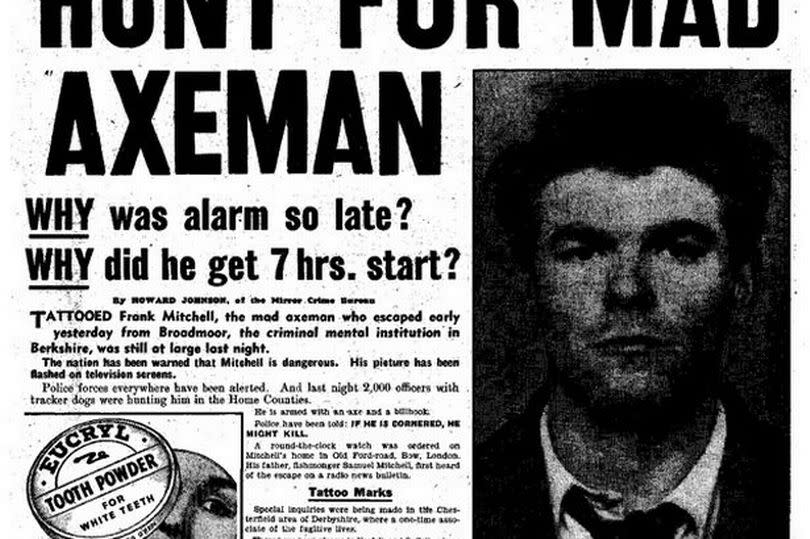Notorious criminals who escaped Dartmoor Prison - including one never seen again
Living in the shadow of Dartmoor Prison, locals have a front-row seat to some truly wild tales - from bold prison breakouts to raging riots. Although many of these stories take on a legendary status, there are a few so extraordinary they teeter on the brink of incredulity.
Consider, for example, the notorious 'mad axeman' whose daring escape from the imposing prison over half a century ago continues to captivate curious minds. Frank Mitchell, serving a life sentence at the time, disappeared under the pretence of feeding some of Dartmoor's trademark ponies.
Technically, Mitchell is still at large, holding the record as the longest-standing escapee of the 20th century. However, it is widely suspected that he was the victim of foul play and subsequently killed.
Not every prisoner who attempted to break free from the confines of Dartmoor was as 'successful' as Mitchell. In the chaos of a riot and fire in 1932, a combined effort by soldiers and warders foiled the escape plans of nearly 30 inmates.
These days, Dartmoor Prison operates as a much safer establishment, no longer plagued by the security challenges that marked its history during the '30s, '40s and '50s, Plymouth Live reports.
Here's a look at some of Dartmoor's most infamous escapees.
Frank Mitchell AKA 'Mad Axeman'.
Known as the "Mad Axeman" after holding an elderly couple hostage with an axe, Frank Mitchell landed himself a life sentence in the formidable HMP Dartmoor.
Despite his terrifying reputation of violence, Mitchell mysteriously disappeared 50 years ago and has remained elusive ever since.
His disappearance, aided by notorious gangsters Ronnie and Reggie Kray, triggered the largest-ever manhunt in the country, involving 200 police officers, 100 Royal Marines and a Royal Air Force helicopter combing the moors.
He made his daring escape on December 12, 1966, while repairing fencing on the firing range at Bagga Tor with fellow inmates. Under the watch of just one prison officer, Mitchell managed to slip away under the pretence of feeding some Dartmoor ponies.
In reality, he was picked up by two men near Princetown and by the time authorities were searching the road from Dartmoor, he was savouring a steak in an East London flat.
This would be the last sighting of Mitchell whose body has never been found. Officially, Mitchell remains a fugitive from Dartmoor, making him the longest-running escapee of the 20th century.
However, it is widely believed that he was murdered as part of a gangland feud on December 24, 1966, although reports suggest Ronnie Kray insisted he was not killed but rather, with his and Reg's help, was smuggled out of the country. The incident led to questions about the prison's security measures in the House of Commons.

Despite being a significant risk and not due for release for many years, Mitchell had been allowed to join prisoners' work parties outside the prison.
These tasks on the moor, also referred to as honour parties, were typically reserved for inmates nearing their release date.
The prison's lax regime allowed Mitchell to easily sneak off to the Elephant's Nest pub in Horndon, near Mary Tavy, and the Peter Tavy Inn. Astonishingly, just a month prior to his escape, Mitchell even managed to hail a taxi from the Elephant's Nest to Tavistock.
Harold 'Rubber Bones' Webb
Harold 'Rubber Bones' Webb earned his nickname on November 19, 1951, when he wriggled his way to freedom through the hot air warming ducts. He achieved this by prying open the floor of his cell, squeezing through the shafts, and sawing through the air intake bars.
Webb posed as a track worker and hopped on a train at Brent Tor station to get to Exeter. From there, he hitch-hiked his way to London.
However, Webb was back in custody within a week.
William 'Foxy' Fowler

In 1957, London mobster Foxy Fowler made his escape through the toilets in the prison's museum.
The museum itself admits on its website: "They had recently been installed but the builders neglected to fit the windows with bars!".
One of the most infamous criminals of his time, he earned his nickname due to his frequent attempts to escape.
Foxy managed to break out of the high-security Parkhurst prison on the Isle of Wight twice. On one occasion, he even stole a boat and sailed it single-handedly up the coast.
The criminal was once apprehended by police who found him spending the night with a certain "lady of leisure'', with a gun and bullets stashed under his pillow.
Charles 'Ruby' Sparks
The infamous cat burglar and jewel thief, Charles 'Ruby' Sparks, was at the centre of a sensational escape bid during a prison riot in January 1932. During the disturbance, prisoners set fire to parts of the jail and amid the ensuing chaos, around 30 inmates tried to break out.
Their escape attempt was foiled by the swift intervention of armed police and military personnel from Crownhill Barracks. Sparks was serving a five-year sentence for burglary, known at the time as housebreaking, when the rioters made a violent push for the main gates, hoping to force their way out despite the ring of armed guards around the prison.
The convicts, armed with makeshift weapons, were ultimately subdued by a squad of baton-wielding officers. In January 1940, Sparks found himself incarcerated once more; however, this time he managed to flee, evading capture for 170 days and becoming one of the most sought-after escapees.
His nickname 'Ruby' traces back to his younger days following a theft in Mayfair, London, where he stole a box of 40 red gems. After being misled into thinking they were mere glass, Sparks casually handed them out to acquaintances in Soho clubs. He later learned from newspaper reports that the stones were in fact valuable rubies from an Indian Maharaja's collection, worth £40,000.
Additionally, his alias "Rubberface" was coined due to the strange faces he would pull in police mugshots.
John Morgan
In the 1800s, newspapers were often filled with thrilling tales of prisoners' audacious escape bids. One such tale that captured public attention was that of John Morgan, who famously broke free from HMP Dartmoor in 1898. The newspaper article detailed: "Another convict escaped from Dartmoor convict establishment on Sunday night, but was recaptured last evening (Monday) after an exciting chase. The man, whose name is John Morgan, alias Henry Harley, was serving his third term of penal servitude, his last conviction having been at the North London sessions in 1894, when he was sentenced to 10 years penal servitude for larceny.
"The alarm was raised at 8.40pm on Sunday by a night-watchman in the prison who saw a couple of knotted blankets hanging out of a cell window. It was found that the ventilator of the cell had been taken out as well as the pane of glass, and two outside iron bars broken through, probably by blows with a stool which was in the convict's cell.
"Morgan then squeezed himself through the small aperture and, using his blankets as a rope, reached the ground. He scaled the high boundary wall by means of a scaffold pole and, by the time he was missed, he had got clean away from the prison.
"Armed search parties were sent out, and mounted men and cyclists scoured the country in all directions. It was a bright moonlit night, but in spite of this and of the open nature of the county, Morgan managed to elude his pursuers throughout the night and until the following afternoon was well advanced, when he was run down near Chagford, a village about 12 miles on the Exeter side of Dartmoor."

 Yahoo News
Yahoo News 
